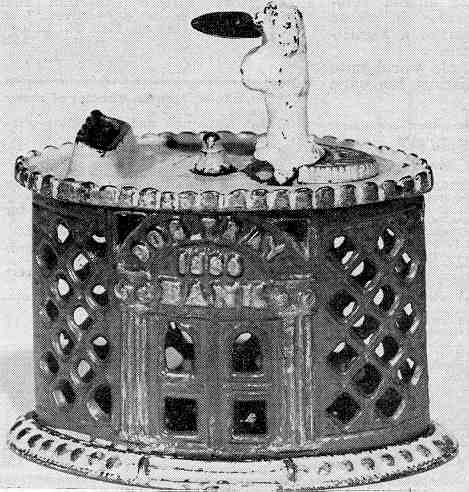Dog Tray Bank
by F.H. Griffith - HOBBIES Magazine - October, 1958

A very simple but hard to find mechanical bank is our choice as No. 68 in the numerical classification of the mechanical banks. This bank, the Dog Tray, has the desirable feature of depending upon the weight of the coin to cause its operation. Banks using this principle were in the main designed and patented by John Hall of Watertown, Mass., and manufactured by the J. & E. Stevens Company of Cromwell, Conn. John Hall was apparently obsessed with the idea of the coin itself taking part in the action and causing the action to take place. He was noted for Hall’s Excelsior (earliest known dated mechanical bank, 1869), Tammany, Lilliput, and the Horse Race Bank. The Dog Tray, however, has an entirely different background and history.
The Dog Tray Bank was patented September 21, 1880, by Louis Kyser and Alfred C. Rex of Philadelphia, Pa., and manufactured by them. A quote from the patent papers is of interest: "Our invention relates to that class of toy money boxes in which the weight of the money to be deposited causes the figure to move; and our invention consists in so balancing a figure of a dog or other animal, sitting upon its haunches, that when a piece of money is placed upon a plate, held in its mouth, the center of gravity is changed and the animal tips over slightly to one side until the money slides off into an opening in the box, and the figure once more regains its original position." So, of course, the main purpose and idea in back of the bank was the principle of the operation caused by the weight of the coin.
The bank shown was obtained some years ago from A. L. Cooper of Dayton, Ohio. It is in extra fine original condition and the paint is also unusually good. The base or building part of the bank is blue and the bottom edge and top of the building are yellow with gold high-lighting. The entrance way, name and date are also in gold. The dog is white and he holds a gold tray in his mouth.
The operation of the bank, as previously mentioned, is quite simple. A coin is placed on the tray held in the dog’s mouth, this causes the figure to tilt forward and the coin slides from the tray into the provided slot. The dog then returns to the position shown in the picture.
The bank is made in four main parts, the top, bottom, and two curved sections to form the front and back of the building. The bank is held together by one bolt that clamps the top and bottom onto the two curved sections. This bolt has a round head and two lugs on the bottom. These lugs simply tighten into a slot when the bolt is turned. It is necessary to take the bank apart to remove the coins. The method of fastening this bank together is brought out since it has some bearing on the scarcity of the bank itself. It is not a very secure method of holding the bank together and it is reasonable to assume that with any degree of usage by a child a part could be easily lost or misplaced and subsequently the rest of the bank discarded. The collector of today is fortunate if he can find the Dog Tray Bank in complete original condition.
